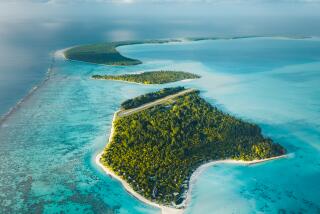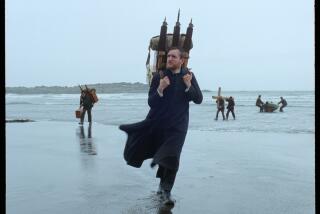Lured by a webcam to the world of Lapland
- Share via
FOR THE LAST three years, I’ve been staring at a webcam of northern Finland. Sitting in my home office in the French Mediterranean city of Marseilles, I’ve kept tabs on Rovakatu Street, the major thoroughfare of Rovaniemi, a town of 30,000 right on the Arctic Circle.
I first stumbled upon the site (https://www.rovaniemi.fi/moduls/360/rovakatu.aspsek10) when I was surfing online for weather forecasts for Lapland, in preparation for my first trip there to shoot a photo essay inspired by Arto Paasilinna’s novel, “The Year of the Hare.” What started as intelligence-gathering soon became a kind of exotic obsession.
Not because there’s anything particularly attractive or rock ‘n’ roll about Rovaniemi; quite the opposite. The view down Rovakatu Street is bland and lifeless, to the point that Marie, my girlfriend, refuses to look at it. “How gloomy!” she says, making a face. The town’s main claim to fame, not visible online, is that it’s the hometown of Santa Claus.
I initially assumed that everything on camera would somehow reflect Lapland’s identity. I imagined that a herd of reindeer might show up from around the corner, or that in winter, sleighs would replace cars.
No such luck: just normal-looking automobiles, blurry people and this never-ending gray light. After a while, I found this reassuring. Rovaniemi, in the end, has the same texture as any other European town.
Refreshing the site as many as three times a day became a kind of therapy, an escape from the urban pressure and chaos of Marseilles, with its narrow streets choked with cars and people, often under crushing summer heat. It was comforting to know that there is a place, somewhere, calmer than where I live all year long. We had two small children, and I couldn’t travel as before, so the webcam allowed me to transport myself a little each day.
But in May of this year, the serenity became too seductive to resist. I decided to take a reality tour of the place I had only known virtually.
Rovaniemi was immediately familiar. Though it took two connecting flights to get there, I felt like I had walked directly through the computer screen without a layover. I was a time traveler, a character or extra on a theater stage with scenery I know by heart.
Rovakatu Street crosses the city center and is lined with stores, restaurants and the usual things you find in European cities. On one side: the familiar Fotox sign. Blue on the computer screen, it turns out to be green in real life.
And the little booth? I’d always imagined that it was a hot dog stand. But I was wrong -- it’s an ice cream parlor. The weather was frigid on the day of my visit, so the parlor was closed. But a few days later, with temperatures climbing to 60 degrees, business would resume in full swing.
All this time I had wondered: Why do cars park always on the left side of the street in the evening, and only for a very brief period of time? Is there a bar? A condom vending machine? A spot for a quickie rendezvous? I discovered the reason is in fact an ATM, named “Otto.”
I could never tell from the webcam whether the city was big or small. Driving in from the airport, I missed the exit because I couldn’t even see the town, hidden as it is between two rivers. Rovaniemi was destroyed by the Nazis in 1944, then rebuilt according to plans by the famed Finnish architect Alvar Aalto. It’s often cited as a model for successful urbanization.
To the right side of the screen, on Pekankatu Street, a smooth-looking, roundish building has always seemed to me like a World War II bunker. In person, it’s a bubble-shaped parking garage littered with cigarette butts and stinking of urine. In the evenings, young Finns eat hamburgers there, smoking and having a chat. Then they roar into the streets in customized cars and do giant doughnuts, using the town as their own Grand Prix circuit. Nobody seems to mind.
Down the street, I was intrigued to discover a photographer’s workshop displaying portraits of young people in white caps.
This has been the local students’ headgear since the 19th century. Originally the hats were blue, but in 1875, high school students ready to graduate switched to white to imitate their compatriots in Sweden. Students also wear them on May 1, when they celebrate the end of the school year.
With temperatures hovering around the freezing level, Lapland was slowly shifting from winter to the days of never-ending light. At my feet I saw the last pile of dirty snow melting into a puddle.
Back home in Marseilles it was 78 degrees, Marie told me on the phone. Then I walked into the street, carefully positioning myself in the frame, not too forward, not too far away. Marie took a screen capture of me on Rovakatu Street: May 17, 10:28 a.m.
I have enjoyed looking at webcams of other places I’ve visited on assignment, such as Budapest, Shanghai and Durban. But I could never quite unlock the mystery surrounding this little stretch of street.
And I still can’t. Since my return, I keep watching. Summer has arrived. A few days ago, the street was filled with red tents, and a week before that, the road was divided by red and white cones, while police officers roped off an area with yellow tape.
What’s going on? I’ll have to keep watching to find out.
More to Read
Sign up for The Wild
We’ll help you find the best places to hike, bike and run, as well as the perfect silent spots for meditation and yoga.
You may occasionally receive promotional content from the Los Angeles Times.






